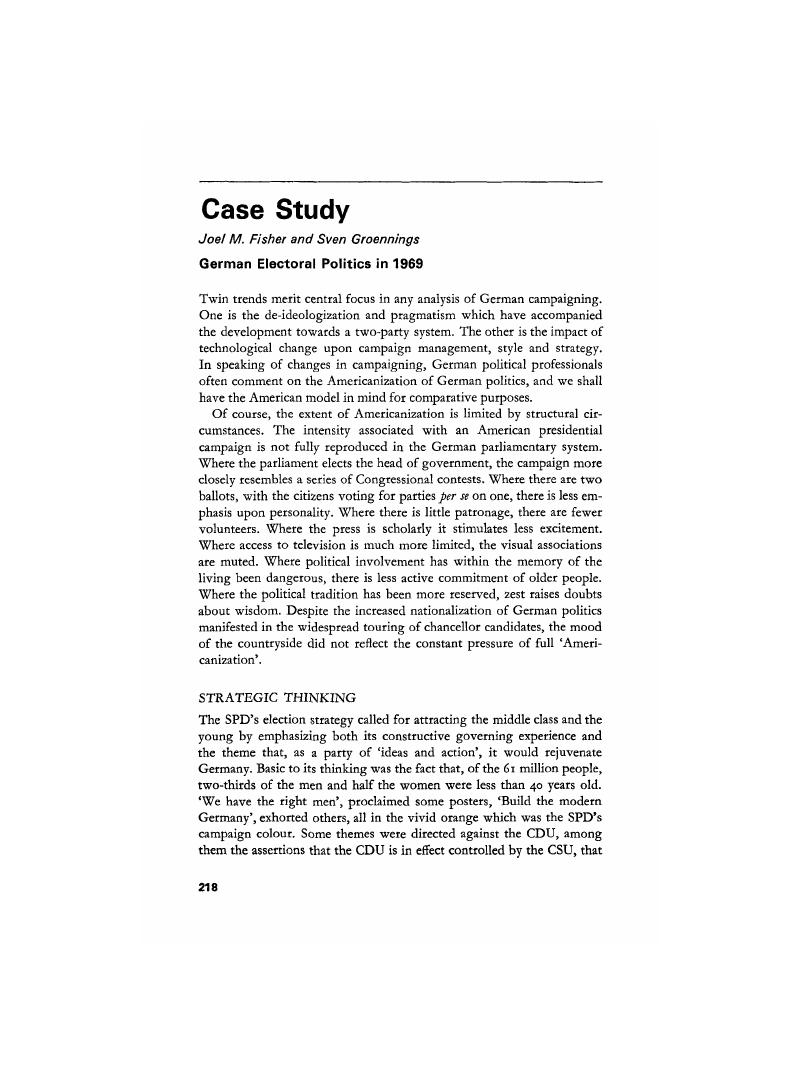No CrossRef data available.
Article contents
German Electoral Politics in 1969
Published online by Cambridge University Press: 28 March 2014
Abstract

- Type
- Case Study
- Information
- Copyright
- Copyright © Government and Opposition Ltd 1970
References
1 Many were testimonial advertisements in which prominent citizens in various walks of life indicated why they would say ‘yes’ to the SPD. The first advertisement depicting Willy Brandt resulted in 25,000 letters of support.
2 Next to a CDU poster proclaiming ‘Auf den Kanzler Kommt es an’, a transcript of Brandt retorting, ‘Auf den Wâhler Kommt es an’ – ‘It all depends on the voter’ could frequently be heard.
3 Brandt had said in the newspaper advertisements: ‘Let us talk about the future’. SPD handouts also conveyed the theme: ‘SPD – the best future you can possibly choose’.
4 All figures taken from The Bulletin, Bonn, 30 September 1969, p. 261.
5 There had been substantial federal financial support of the 1965 campaign also, but on an entirely different basis. In 1958 the Federal Constitutional Court ruled against tax deduction of campaign contributions by interest group conveyers.-, which had benefitted the CDU/CSU and FPD, on grounds that financial relief should be equally proportionate. Soon thereafter the government introduced federal subsidies to be shared by the parties. Three times the subsidies were increased, finally in 1964 to 38 million DM per year. Because state and communal governments also appropriated subsidies, the total at all levels exceeded 50 million. These funds were used in part to fuel the 1965 campaign. In 1966 the Court ruled that subsidies to finance all manner of party activities were unconstitutional. The presently applicable Parties Law of 1967 provided financial assistance for the more limited purpose of campaigning. For the greatest available background detail, see Arnold J. Heidenheimer and Frank C. Langdon, Business Associations and the Financing of Political Parties, The Hague, 1968, pp. 71–88.
6 While the 65 million DM figure is frequently cited, Der Spiegel reported on 25 July 1966 (p. 2), that the parties’ treasurers had jointly estimated expenses of 83·3 million in 1965.
7 The 100 million DM estimate was published frequently; however, given the 96 million subsidy, party savings from other years to be spent in the election year, and 17 million in membership dues collected by the SPD alone, the 100 million is an underestimation unless virtually all non-governmental income were classified as normal operating costs. The SPD and CDU probably each have budgets of 17–20 million DM for annual operating expenditures exclusive of campaign costs.
8 Before the September elections, the federal treasury paid out the following advance payments: 22·6 million DM to the SPD; 21·8 million DM to the CDU; 5·5 million DM to the CSU; 5·4 million DM to the FDP; and 1·2 million DM to the NPD. See: Inter-Nationes Press Release (September 1969), p. 2.
9 By way of historical elaboration, the conveyers sought, with some success, to reshape the party system by making anti-socialist, coalition-oriented campaigns a condition of their grants. They also attempted to play a key role in candidate selection, a practice which sometimes led to direct confrontation between party chairmen and business executives.
10 The SPD’s 1959 Bad Godesberg programme helped to allay business fear of socialist hostility and probably had the effect of reducing business interest in making non-deductible donations to the CDU. In 1961 the FDP made enlarged subsidies a condition of its participation in the governing coalition.
11 As one might expect, the SPD was critical of state financing from the very beginning. However, it gradually altered its position after 1965 so as to increase its bargaining strength within a potential coalition. In 1966 the SPD officially argued in court that state financing was in principle constitutional.
12 The SPD divided its income as follows: 15 per cent federal, 30 per cent state, 55 per cent district. The federal campaign, which is the central campaign, covered the cost of posters, newspaper advertising, brochures, pennants, photos, and the production of television shows. As can be observed from the SPD budget, the major parties, in comparison to their American counterparts, allocated a smaller proportion of their resources to television. It has been carefully estimated that the cost of American campaigns at all levels in 1968 was about $300 million. Television costs probably exceeded $11 million just for the three presidential candidates in the period following their nomination. Given these phenomenal outlays, there have been proposals in the United States to subsidize voters’ pamphlets as well as radio and television messages.
13 By 1969, there existed 30–40 German survey research units, including six national commercial, non-university companies. There were also at least two party units (CDU and SPD) and perhaps two major academic centres. Source: interview with Max Kaase, University of Mannheim, 23 September 1969.
14 In 1965, 38,510,395 were eligible, of whom 33,416,207 voted – again a figure of 86·8 percent.
15 Its smallest loss, 1·6 per cent in the Saarland, occurred when the FDP was involved in a local coalition formed at the state level.
16 Elschner, Gerhard, ed., Wahlanalyse 69, Bonn, WIKAS, 1969, pp. 28–30.Google Scholar
17 Statement by Bruno Heck at the CDU’s 17th convention recorded by David Binder, ‘Kiesinger-under Attack as Party Meeting Opens’,-, New York Times, 18 November 1969.
18 See especially Otto Kirchheimer’s ‘Germany: The Vanishing Opposition’, in Dahl, Robert A., ed. Political Opposition in Western Democracies, New Haven, 1966, pp. 237–59.Google Scholar


